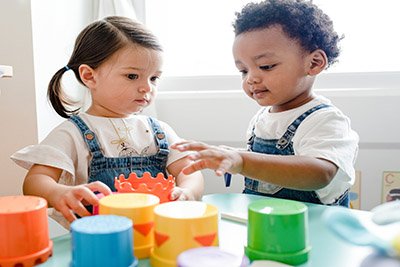The Individualized Family Service Plan (IFSP) ends when a child turns 3. Transitioning to a services under an Individualized Education Program (IEP) requires a new evaluation and is a team-led process. Let this handout serve as your cheat sheet for the differences between the IFSP and IEP.
| Individualized Family Service Plan (IFSP) | Individualized Education Program (IEP) |
|---|---|
| Ages: Birth (0) to 3 years old Governed by: Individuals with Disabilities Education Act (IDEA), Part C Also known as early intervention services (EIS) | Ages: 3-21 years old Governed by: Individuals with Disabilities Education Act (IDEA), Part B Also known as special education services |
| Eligibility Criteria | Eligibility Criteria |
| Division 125% or 1.5 SD (Standard Deviation) below the mean in one or more of the following areas of development: 1. Cognitive 2. Physical (fine or gross motor) 3. Communication (receptive or expressive language) 4. Social or Emotional 5. Adaptive or – Diagnosed physical or medical condition that has a high probability of resulting in delay, such as but not limited to: Chromosomal abnormalities Genetic or congenital disorders Sensory impairments Inborn errors of metabolism Disorders reflecting disturbance of the development of the nervous system Congenital infections Severe attachment disorders Disorders secondary to exposure to toxic substances, including fetal alcohol syndrome | 2 SD (Standard Deviation ) below the mean in one or more areas of development or – 1.5 SD below the mean in two or more areas of development meaning – Has one or more of the following disabilities 1. Developmental Delay (ages 3-8) Upon his/her 8th birthday, your child must be eligible under a different category 2. Specific Learning Disability 3. Intellectual Disability 4. Autism 5 Hearing Impairment 6. Emotional Disturbance 7. Deaf-blindness 8. Multiple Disabilities 9. Orthopedic Impairment 10. Other Health Impairment 11. Deafness 12. Speech/Language Impairment 13. Traumatic Brain Injury and – The disability/disabilities adversely affect his/her educational performance and – His/her unique needs cannot be addressed through education in general education classes alone, with or without individual accommodations, and require specially designed instruction (SDI) |
| Administered by: Early Support for Infants and Toddlers | Administered by: Washington Office of Superintendent of Special Instruction (OSPI) |
| Focus Subject of Services | Focus Subject of Services |
| The IFSP outlines the family’s needs in supporting the child’s developmental progress. During the first three years of development, the child’s needs are closely related to the needs of the family. Recognizing parents as major contributors in development, the IFSP builds upon the individual strengths of the family to address the needs of the child. | The IEP is a comprehensive plan for school-age children, addressing their educational needs and academic goals. The IEP specifies the special education services, goals, and accommodations necessary for the child’s education. Goals are typically related to academic, functional, and behavioral areas. |
| Location of Services | Location of Services |
| Infants and toddlers usually spend their days at home or in childcare settings. These are their “natural environment”. By receiving their IFSP services in the natural environment, the family learns to use natural learning opportunities (like playtime, meals, or baths) to create countless opportunities for the child to practice and develop delayed skills. It also includes the family’s social and cultural networks, promoting full participation in community life. | At age 3, a child becomes eligible for special education and related services. They may receive services through a preschool, center based and family childcare center, Early Childhood Education and Assistance Program (ECEAP), or Transitional Kindergarten. IEP services must be provided in the “least restrictive environment”, meaning that the child should be with typically developing peers (those without disabilities) as much as the team agrees is appropriate for the child. |
| Frequency of Review and Re-Evaluation | Frequency of Review and Re-Evaluation |
| The IFSP has two different types of reviews: The periodic review occurs at least every six months, or more frequently if necessary for the child’s condition. During the review, the team discusses progress toward family outcomes (goals), any new assessment information, and whether the IFSP needs to be changed or updated. At the annual meeting, the team will update the present levels of development, develop new outcomes bearing in mind the family’s priorities, and consider services that will be needed and provided moving forward. | The IEP must be reviewed, at a minimum, yearly. This annual review allows the IEP team to assess the student’s progress, make any necessary adjustments to goals and services, and ensure that the IEP continues to meet the student’s needs. Every three years, a reevaluation is conducted if deemed necessary. This reevaluation can help determine if the student’s disability and needs have changed and if the services and goals in the IEP need modification. *Parents may request an IEP meeting at any time. |
This article can be found as pages 5 and 6 of the 3-5 Transition Toolkit

